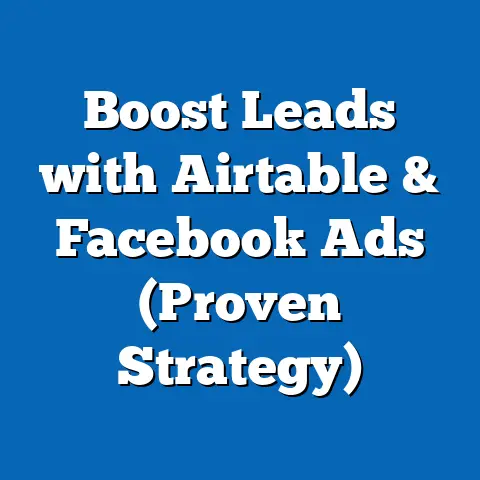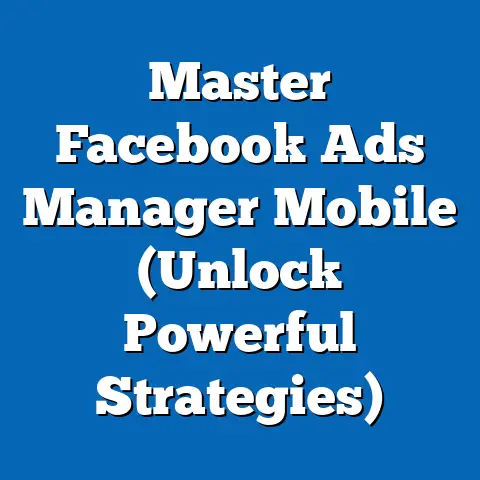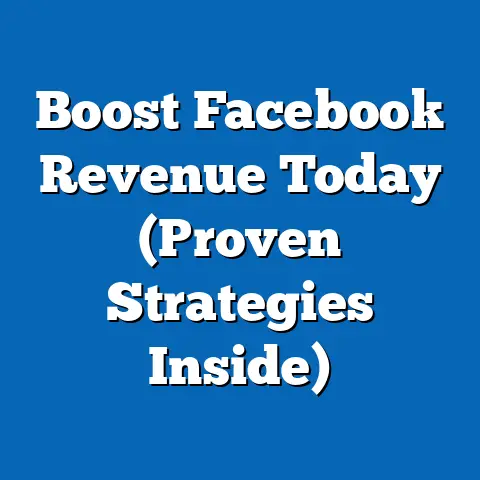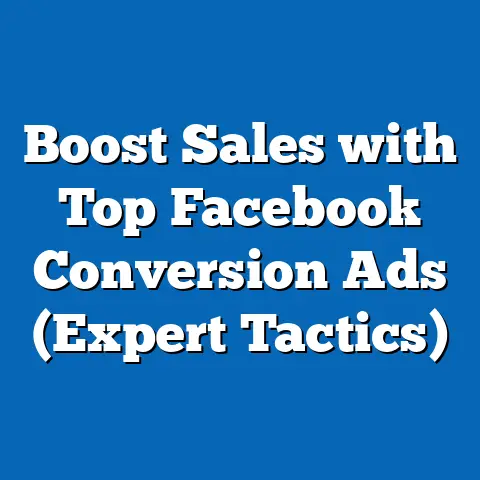Stop Blocked Ads on Facebook (Proven Tactics for Success)
Have you ever poured your heart and soul (and budget!) into crafting what you thought was the perfect Facebook ad, only to have it rejected or blocked? It’s a frustrating experience, one I know all too well. I’ve been there, staring at the “Disapproved” notification, wondering what went wrong and how to fix it. If you’ve felt this way, you’re not alone. Many marketers and business owners struggle with navigating Facebook’s often-complex advertising policies.
Facebook ads are undeniably a powerful tool for digital marketing. They offer unparalleled reach, precise targeting, and the potential to drive significant business growth. But when your ads are constantly getting blocked, it’s like trying to drive with the brakes on. It hinders your marketing efforts, wastes your budget, and can leave you feeling completely demoralized.
1. Understanding Facebook Ad Policies
Facebook’s advertising policies are the foundation upon which all successful (and compliant) campaigns are built. Think of them as the rules of the road. You can’t just jump in a car and start driving without knowing the traffic laws, right? Similarly, you can’t expect to run effective Facebook ads without understanding the platform’s advertising guidelines.
These policies are designed to protect users, maintain the integrity of the platform, and ensure a positive advertising experience for everyone. While they can sometimes feel restrictive, they’re ultimately in place to create a trustworthy and valuable environment for both advertisers and users.
Why Ads Get Blocked: Common Reasons
Over the years, I’ve seen ads blocked for a whole host of reasons. Here are some of the most common culprits:
- Inappropriate Content: This is a broad category that includes ads containing hate speech, violence, sexually suggestive content, or anything that exploits, abuses, or endangers children. It’s a no-brainer, but it’s crucial to be mindful of the content you’re promoting.
- Misleading or Deceptive Claims: Facebook takes a dim view of ads that make false or exaggerated claims about products or services. This includes unsubstantiated health claims, get-rich-quick schemes, and deceptive marketing practices. Honesty and transparency are key!
- Violation of Community Standards: This is where things can get a little more nuanced. Facebook’s Community Standards outline the acceptable behavior and content on the platform. Ads that violate these standards, even indirectly, can be blocked. This might include promoting products or services that facilitate illegal activities or targeting sensitive topics in an insensitive way.
- Personal Attributes: You can’t directly or indirectly assert or imply a person’s personal attributes like race, ethnic origin, religion, age, sexual orientation, gender identity, disability, or medical condition. For example, an ad saying “Meet other gay singles in your area!” is a no-no.
- Sensational Content: Ads that are overly shocking, sensational, disrespectful, or excessively violent are often rejected. Facebook aims to maintain a respectful and appropriate environment.
- Functionality Issues: This might seem obvious, but ads with broken links, malfunctioning landing pages, or other technical issues will be blocked. Always double-check your links and ensure your website is functioning correctly.
- Low Quality or Disruptive Content: Ads that are grammatically incorrect, visually unappealing, or otherwise disruptive to the user experience can also be rejected. Quality matters!
- Controversial Topics: Tread carefully when dealing with sensitive issues such as politics, religion, or social issues. These topics can be highly divisive and may trigger negative reactions or policy violations.
The Importance of Knowing the Policies
I can’t stress this enough: thoroughly understanding Facebook’s advertising policies is essential. It’s not just about avoiding getting your ads blocked; it’s about building a sustainable and successful advertising strategy. Here’s why:
- Compliance: Obviously, knowing the rules helps you stay compliant and avoid penalties.
- Efficiency: By creating compliant ads from the outset, you save time and resources by avoiding the need for revisions and appeals.
- Trust: Running ethical and compliant ads builds trust with your audience and enhances your brand reputation.
- Long-Term Success: A long-term advertising strategy is only possible if you play by the rules.
Takeaway: Familiarize yourself with Facebook’s advertising policies. It’s time well spent and a crucial investment in your advertising success. Check the Facebook Ads Help Center regularly for updates, as these policies can and do change.
2. Crafting Compliant Ad Content
Okay, so you understand why you need to follow Facebook’s ad policies. Now, let’s get into the how. Crafting compliant ad content is a skill that requires careful attention to detail and a deep understanding of what Facebook considers acceptable. It’s not just about avoiding obvious violations; it’s about creating ads that are both engaging and respectful of the platform’s guidelines.
Best Practices for Writing Compliant Ad Copy
The words you use in your ad copy are incredibly important. They can make or break your campaign, both in terms of performance and compliance. Here are some best practices to keep in mind:
- Avoid Prohibited Words and Phrases: Facebook maintains a list of prohibited words and phrases that are often associated with violations of their policies. While this list isn’t publicly available, you can get a sense of what to avoid by paying attention to common reasons for ad rejections. Words related to health conditions, financial struggles, or personal attributes are often flagged.
- Focus on Benefits, Not Claims: Instead of making direct claims about your product or service, focus on the benefits it provides to the user. For example, instead of saying “Cure your acne in 7 days!” try “Achieve clearer, healthier skin with our revolutionary skincare system.”
- Use Inclusive Language: Be mindful of the language you use and avoid making assumptions about your audience’s personal attributes. Use gender-neutral language where appropriate and avoid stereotypes.
- Be Specific and Transparent: Provide clear and accurate information about your product or service. Avoid vague or misleading statements.
- Proofread Carefully: Grammatical errors and typos can make your ad look unprofessional and may even raise red flags with Facebook’s automated systems. Always proofread your ad copy carefully before submitting it.
- Avoid Clickbait: Don’t use sensational headlines or misleading tactics to entice users to click on your ad. This can lead to a negative user experience and may result in your ad being blocked.
Example:
Non-Compliant: “Finally lose weight fast with our revolutionary diet pill!” (Makes an unsubstantiated health claim)
Compliant: “Support your weight loss journey with our delicious and nutritious meal replacement shakes.” (Focuses on benefits and avoids specific claims)
The Significance of Images and Videos
Visuals are a crucial component of any successful Facebook ad. They’re often the first thing users see, and they play a significant role in capturing attention and conveying your message. However, it’s important to choose your visuals carefully and ensure they comply with Facebook’s advertising policies.
Non-Compliant: An image of a heavily photoshopped model with unrealistic body proportions to advertise a weight loss product.
Compliant: A video testimonial from a real customer sharing their positive experience using a fitness program.
Takeaway: Crafting compliant ad content requires a careful balance of creativity and adherence to Facebook’s guidelines. By following these best practices, you can create ads that are both engaging and respectful of the platform’s policies, reducing the risk of getting blocked and maximizing your advertising success.
3. Targeting the Right Audience
Targeting is the heart and soul of Facebook advertising. It’s what allows you to reach the people who are most likely to be interested in your product or service. But improper targeting can not only lead to wasted ad spend; it can also lead to ad rejections.
How Improper Targeting Can Lead to Ad Rejections
You might be thinking, “How can targeting lead to ad rejections?” Here’s the thing: Facebook wants to ensure that ads are relevant and respectful of its users. If your targeting is too broad, too narrow, or based on sensitive personal attributes, it can raise red flags.
- Discrimination: Targeting based on protected categories like race, ethnicity, religion, age, sexual orientation, gender identity, disability, or medical condition is strictly prohibited. This is considered discriminatory and will result in immediate ad rejection.
- Privacy Violations: Targeting based on overly specific or sensitive information that users haven’t explicitly shared can be seen as a violation of privacy. This might include targeting users based on their political affiliations, financial status, or health conditions.
- Irrelevant Ads: Targeting a broad audience with an irrelevant ad can lead to negative feedback and may even result in your ad being blocked. Facebook wants to ensure that users are seeing ads that are relevant to their interests.
- Misleading Claims: Using targeting to make misleading claims about your product or service is also prohibited. For example, targeting users who are likely to be struggling financially with an ad that promises unrealistic financial gains.
Tactics for Selecting the Right Audience
So, how do you target the right audience without running afoul of Facebook’s policies? Here are some proven tactics:
- Demographic Targeting: Use demographic data like age, gender, location, education, and job title to reach specific groups of people. This is a basic but effective way to narrow your audience and ensure your ads are relevant.
- Interest-Based Targeting: Target users based on their interests, hobbies, and activities. This is a powerful way to reach people who are passionate about specific topics and likely to be interested in your product or service. Facebook gathers this information based on the pages people like, the groups they join, and the content they interact with.
- Behavioral Targeting: Target users based on their online behavior, such as their purchase history, device usage, and travel habits. This can be a highly effective way to reach people who are actively looking for products or services like yours.
- Custom Audiences: Create custom audiences based on your existing customer data, such as email addresses, phone numbers, and website visitors. This allows you to target people who have already interacted with your business and are more likely to convert.
- Lookalike Audiences: Create lookalike audiences based on your custom audiences. This allows you to reach new people who share similar characteristics and behaviors as your existing customers.
Understanding Your Audience’s Preferences and Behaviors
The key to successful targeting is understanding your audience’s preferences and behaviors. The more you know about your target audience, the better you can tailor your ads to their specific needs and interests.
- Conduct Market Research: Conduct thorough market research to understand your target audience’s demographics, interests, and behaviors. This can involve surveys, focus groups, and analysis of your existing customer data.
- Analyze Your Website Data: Use Google Analytics or other web analytics tools to track your website visitors’ behavior and identify their interests.
- Monitor Social Media: Monitor social media channels to see what your target audience is talking about and what content they’re engaging with.
- Use Facebook Audience Insights: Facebook Audience Insights is a powerful tool that allows you to learn more about your target audience’s demographics, interests, and behaviors.
Example:
Let’s say you’re selling yoga mats. A good targeting strategy might involve:
- Demographics: Targeting women aged 25-55 who live in urban areas.
- Interests: Targeting users who are interested in yoga, meditation, fitness, and healthy living.
- Behaviors: Targeting users who have purchased yoga-related products online in the past.
Takeaway: Targeting the right audience is essential for both advertising effectiveness and compliance. By avoiding discriminatory practices, respecting user privacy, and understanding your audience’s preferences, you can create ads that are relevant, engaging, and less likely to be blocked.
4. Testing and Iterating Your Ads
In the ever-evolving world of Facebook advertising, what works today might not work tomorrow. That’s why testing and iterating your ads is crucial for long-term success. It’s not enough to simply create an ad and hope for the best. You need to continuously experiment with different variations, analyze the results, and make adjustments based on what you learn.
The Concept of A/B Testing
A/B testing, also known as split testing, is a method of comparing two versions of an ad to see which one performs better. You create two variations of the same ad, with one element changed (e.g., headline, image, call to action), and then show each version to a random segment of your audience. By tracking the performance of each version, you can determine which one is more effective in terms of clicks, conversions, or other metrics.
Why A/B Testing is Crucial
A/B testing is crucial for several reasons:
- Improved Performance: By testing different variations of your ads, you can identify the elements that resonate most with your audience and optimize your campaigns for maximum performance.
- Reduced Risk: A/B testing allows you to test new ideas and strategies without risking your entire budget. You can start with a small test and then scale up the winning variations.
- Better Understanding of Your Audience: A/B testing provides valuable insights into your audience’s preferences and behaviors. You can learn what types of headlines, images, and calls to action they respond to best.
- Compliance: A/B testing can help you identify potential compliance issues with your ads. By testing different variations, you can see which ones are more likely to be approved by Facebook.
A Step-by-Step Guide to Effective A/B Testing
Here’s a step-by-step guide to conducting effective A/B tests:
- Identify a Goal: What do you want to achieve with your A/B test? Do you want to increase clicks, conversions, or engagement? Define your goal clearly before you start testing.
- Choose a Variable to Test: What element of your ad do you want to test? Some common variables to test include:
- Headline
- Image
- Call to Action
- Ad Copy
- Targeting
- Create Two Variations: Create two variations of your ad, with only one element changed. For example, you might create two variations of the same ad with different headlines.
- Set Up Your Test: Use Facebook’s A/B testing tool to set up your test. Specify the variable you want to test, the audience you want to target, and the duration of the test.
- Run Your Test: Let your test run for a sufficient amount of time to gather statistically significant data. This typically takes at least a few days or even a week.
- Analyze the Results: Once your test is complete, analyze the results to see which variation performed better. Pay attention to key metrics like clicks, conversions, and cost per acquisition.
- Implement the Winning Variation: Implement the winning variation in your ad campaign and continue to monitor its performance.
- Repeat the Process: A/B testing is an ongoing process. Continuously test different variations of your ads to optimize your campaigns for maximum performance.
- Headline
- Image
- Call to Action
- Ad Copy
- Targeting
Example:
Let’s say you’re running an ad for a new e-book. You might A/B test two different headlines:
- Variation A: “Download Your Free E-Book Today!”
- Variation B: “Learn the Secrets to [Your Industry] Success!”
By tracking the click-through rate of each headline, you can determine which one is more effective in attracting clicks.
Analyzing Results and Iterating
A/B testing is only effective if you analyze the results and iterate on your ads based on what you learn. Don’t just run a test and then forget about it. Take the time to understand why one variation performed better than the other.
- Look for Patterns: Look for patterns in your data. Are there certain types of headlines, images, or calls to action that consistently perform well?
- Consider Context: Consider the context of your test. What was happening in the market at the time? Were there any major events that might have influenced the results?
- Don’t Be Afraid to Experiment: Don’t be afraid to experiment with new ideas and strategies. The more you test, the more you’ll learn about your audience and what works best.
Takeaway: Testing and iterating your ads is crucial for long-term success on Facebook. By using A/B testing and continuously analyzing your results, you can optimize your campaigns for maximum performance and ensure that your ads are compliant with Facebook’s policies.
5. Utilizing Facebook’s Tools and Resources
Facebook provides a wealth of tools and resources to help advertisers understand ad performance and compliance. These tools can be invaluable in ensuring that your ads meet the platform’s guidelines and achieve your desired results. Ignoring these resources is like trying to navigate a new city without a map – you might get there eventually, but it’ll be a lot harder and more frustrating.
The Ad Preview Tool
The Ad Preview Tool allows you to see how your ad will look on different devices and placements before you publish it. This is a great way to catch any visual issues or formatting problems that might make your ad look unprofessional or even trigger a rejection.
- Accessing the Ad Preview Tool: The Ad Preview Tool is located within the Facebook Ads Manager. When you’re creating or editing an ad, you’ll see a “Preview” option that allows you to view your ad on different devices and placements.
- Using the Ad Preview Tool: Use the Ad Preview Tool to check the following:
- Visual Appeal: Does your ad look visually appealing on different devices?
- Formatting: Is your ad copy properly formatted? Are there any formatting errors?
- Relevance: Does your ad look relevant to the placement it’s being shown on?
- Compliance: Does your ad contain any elements that might violate Facebook’s policies?
- Visual Appeal: Does your ad look visually appealing on different devices?
- Formatting: Is your ad copy properly formatted? Are there any formatting errors?
- Relevance: Does your ad look relevant to the placement it’s being shown on?
- Compliance: Does your ad contain any elements that might violate Facebook’s policies?
The Ad Manager
The Ad Manager is your central hub for creating, managing, and analyzing your Facebook ad campaigns. It provides a wealth of data and insights that can help you optimize your campaigns for maximum performance.
- Key Features of the Ad Manager:
- Campaign Creation: Create new ad campaigns and define your targeting, budget, and schedule.
- Ad Set Management: Manage your ad sets, which are groups of ads that share the same targeting and budget.
- Ad Creation: Create individual ads with different headlines, images, and calls to action.
- Reporting: Track the performance of your campaigns, ad sets, and ads.
- A/B Testing: Conduct A/B tests to compare different variations of your ads.
- Leveraging the Ad Manager for Compliance:
- Policy Notifications: The Ad Manager will notify you if any of your ads violate Facebook’s policies.
- Performance Monitoring: Monitor the performance of your ads to identify any potential compliance issues. For example, if your ad is receiving a high number of negative feedback reports, it might be a sign that it’s violating Facebook’s policies.
- Campaign Creation: Create new ad campaigns and define your targeting, budget, and schedule.
- Ad Set Management: Manage your ad sets, which are groups of ads that share the same targeting and budget.
- Ad Creation: Create individual ads with different headlines, images, and calls to action.
- Reporting: Track the performance of your campaigns, ad sets, and ads.
- A/B Testing: Conduct A/B tests to compare different variations of your ads.
- Policy Notifications: The Ad Manager will notify you if any of your ads violate Facebook’s policies.
- Performance Monitoring: Monitor the performance of your ads to identify any potential compliance issues. For example, if your ad is receiving a high number of negative feedback reports, it might be a sign that it’s violating Facebook’s policies.
The Facebook Ads Help Center
The Facebook Ads Help Center is a comprehensive resource that provides answers to common questions about Facebook advertising. It’s a great place to start if you’re new to Facebook advertising or if you’re having trouble with a specific issue.
- Accessing the Facebook Ads Help Center: You can access the Facebook Ads Help Center by clicking on the “Help” icon in the Facebook Ads Manager.
- Key Topics Covered in the Help Center:
- Advertising Policies: Detailed information about Facebook’s advertising policies.
- Ad Creation: Step-by-step instructions on how to create different types of ads.
- Targeting: Information about different targeting options.
- Budgeting: Tips on how to set your budget and manage your ad spend.
- Reporting: Information about how to track the performance of your ads.
- Troubleshooting: Solutions to common problems with Facebook advertising.
- Advertising Policies: Detailed information about Facebook’s advertising policies.
- Ad Creation: Step-by-step instructions on how to create different types of ads.
- Targeting: Information about different targeting options.
- Budgeting: Tips on how to set your budget and manage your ad spend.
- Reporting: Information about how to track the performance of your ads.
- Troubleshooting: Solutions to common problems with Facebook advertising.
Example:
Let’s say you’re not sure whether your ad copy violates Facebook’s policies. You can search the Facebook Ads Help Center for information about prohibited words and phrases.
Takeaway: Facebook provides a wealth of tools and resources to help advertisers succeed. By utilizing these tools, you can ensure that your ads meet the platform’s guidelines, optimize your campaigns for maximum performance, and avoid getting blocked.
6. Engaging with Facebook’s Support
Even with the best planning and execution, sometimes things go wrong. Your ad might get blocked even if you believe it’s compliant. In these situations, engaging with Facebook’s support team is crucial. It’s like having a direct line to the rule makers, allowing you to clarify misunderstandings and potentially get your ads approved.
The Process of Appealing Blocked Ads
If your ad gets blocked, don’t panic. The first step is to appeal the decision.
- How to Appeal: In the Ad Manager, you’ll see a notification indicating that your ad has been blocked. Click on the notification to view the details of the rejection. You’ll typically see a reason why the ad was blocked and an option to appeal the decision.
- Provide Context: When appealing, provide as much context as possible. Explain why you believe your ad is compliant with Facebook’s policies. Highlight any relevant information that supports your case.
- Be Respectful: Even if you’re frustrated, it’s important to remain respectful in your communication with Facebook’s support team. Being rude or argumentative will only hurt your chances of getting your ad approved.
Tips for Effective Communication with Support
Communicating effectively with Facebook’s support team is key to resolving issues and getting your ads approved. Here are some tips:
- Be Clear and Concise: Clearly state your issue and what you’re hoping to achieve. Avoid rambling or providing irrelevant information.
- Provide Evidence: Back up your claims with evidence. For example, if you believe your ad is compliant with Facebook’s policies, provide specific examples of how it meets the guidelines.
- Ask Questions: Don’t be afraid to ask questions if you’re unsure about something. The support team is there to help you understand Facebook’s policies and how they apply to your ads.
- Be Patient: Resolving issues with Facebook’s support team can sometimes take time. Be patient and persistent, but don’t be overly aggressive.
Building a Good Relationship with Facebook’s Support
Building a good relationship with Facebook’s support team can be beneficial in the long run.
- Be Proactive: Don’t wait until you have a problem to engage with Facebook’s support team. Reach out to them proactively with questions or concerns.
- Provide Feedback: Provide feedback on your experiences with Facebook’s support team. This can help them improve their services and better assist other advertisers.
- Attend Webinars and Events: Facebook often hosts webinars and events for advertisers. Attending these events can be a great way to learn more about Facebook’s policies and connect with the support team.
Example:
Let’s say your ad for a local restaurant gets blocked because it mentions alcohol. You could appeal the decision by explaining that you’re only advertising the restaurant’s food menu and that the mention of alcohol is incidental. You could also provide evidence that your restaurant is licensed to serve alcohol.
Takeaway: Engaging with Facebook’s support team is crucial for resolving issues and getting your ads approved. By communicating effectively, providing context, and building a good relationship with the support team, you can increase your chances of success.
7. Staying Updated on Policy Changes
Facebook’s advertising policies are not set in stone. They’re constantly evolving to reflect changes in the platform, user behavior, and the broader advertising landscape. What’s compliant today might not be compliant tomorrow. That’s why staying updated on policy changes is crucial for avoiding ad blocks and maintaining a successful advertising strategy. I’ve seen perfectly compliant ads get flagged simply because Facebook updated a policy, and I hadn’t caught the change yet!
The Need to Stay Informed
Staying informed about policy changes is essential for several reasons:
- Compliance: Obviously, staying updated on policy changes helps you stay compliant and avoid getting your ads blocked.
- Efficiency: By knowing about policy changes in advance, you can proactively adjust your ads and avoid the need for revisions and appeals.
- Competitive Advantage: Staying updated on policy changes can give you a competitive advantage. You can be among the first to adapt to the new rules and take advantage of new opportunities.
Resources for Staying Updated
Fortunately, there are several resources you can use to stay updated on Facebook’s advertising policies:
- Facebook’s Official Blog: The Facebook Business blog is a great source of information about new features, policy changes, and best practices for Facebook advertising.
- Facebook Ads Help Center: The Facebook Ads Help Center is regularly updated with the latest information about Facebook’s advertising policies.
- Marketing Forums: Online marketing forums are a great place to connect with other advertisers and share information about policy changes.
- Industry News Websites: Industry news websites like Marketing Land and Search Engine Land often report on Facebook’s advertising policy changes.
- Facebook’s Policy Updates Page: Facebook has a dedicated page for policy updates, which is the most direct source of information.
Being Proactive in Adapting to Policy Changes
It’s not enough to simply read about policy changes. You need to be proactive in adapting to them.
- Review Your Ads Regularly: Regularly review your ads to ensure they comply with the latest policies.
- Update Your Ad Copy: If a policy change affects your ad copy, update it accordingly.
- Adjust Your Targeting: If a policy change affects your targeting, adjust it accordingly.
- Seek Clarification: If you’re unsure about how a policy change affects your ads, seek clarification from Facebook’s support team.
Example:
Let’s say Facebook announces a new policy prohibiting ads that promote unrealistic body image standards. You would need to review your ads for weight loss products and make sure they don’t violate this policy. This might involve removing images of heavily photoshopped models or avoiding language that promotes unrealistic expectations.
Takeaway: Staying updated on Facebook’s advertising policies is crucial for avoiding ad blocks and maintaining a successful advertising strategy. By using the resources available and being proactive in adapting to policy changes, you can stay ahead of the curve and ensure that your ads are always compliant.
Conclusion
Navigating the world of Facebook advertising can feel like a constant tightrope walk, especially when it comes to avoiding blocked ads. But with the right knowledge and strategies, you can minimize the risk of rejections and maximize your advertising success.
Throughout this guide, we’ve covered a range of proven tactics, from understanding Facebook’s often-complex advertising policies to crafting compliant ad content, targeting the right audience, testing and iterating your ads, utilizing Facebook’s tools and resources, engaging with Facebook’s support, and staying updated on policy changes.
Remember, compliance is not just about avoiding penalties; it’s about building a sustainable and successful advertising strategy. By creating ads that are both engaging and respectful of Facebook’s guidelines, you can build trust with your audience, enhance your brand reputation, and achieve your business goals.
I encourage you to implement the tactics shared in this article in your own Facebook advertising campaigns. Start by reviewing your existing ads and identifying any potential compliance issues. Then, use the tools and resources available to optimize your campaigns for maximum performance.
Don’t be afraid to experiment and try new things. The world of Facebook advertising is constantly evolving, so it’s important to be adaptable and willing to learn.
With dedication, persistence, and a commitment to compliance, you can unlock the full potential of Facebook advertising and achieve remarkable growth for your business. Now go out there and create some amazing, compliant ads!






